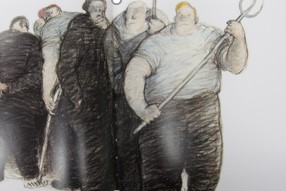Links to the Victorian Curriculum – English
Reading and Viewing, Literature: Responding to literature
Level 5:
- Use metalanguage to describe the effects of ideas, text structures and language features on particular audiences (Content description VCELT314)
Reading and Viewing, Literacy: Interpreting, analysing, evaluating
Level 6:
Writing, Literacy: Texts in context
Level 5:
Level 6:
Links to the Victorian Curriculum – English as an Additional Language (EAL)
Pathway B
Reading and viewing
Level BL:
- Understand and explore the basic layout and conventions of simple texts
(VCEALL200)
- Use basic terminology of reading
(VCEALL202)
Level B1:
- Understand the purpose and basic organisational features of simple text types
(VCEALL280)
- Use some of the terminology of reading
(VCEALL282)
Level B2:
- Understand the purpose and organisational features of common text types
(VCEALL361)
- Understand and use a range of learnt metalanguage to talk about text
(VCEALL363)
Level B3:
- Interpret the purpose and organisational features of different text types
(VCEALL440)
- Understand and use the appropriate metalanguage to talk about the structures and features of a text
(VCEALL442)
Writing
Level BL:
- Understand the difference between writing and drawing, and that writing changes according to context and purpose
(VCEALA219)
- Demonstrate basic keyboard skills
(VCEALL239)
- Use home language and/or mime to seek assistance from teachers or peers with writing English words or phrases
(VCEALA223)
- Contribute ideas to shared writing activities
(VCEALA221)
- Rewrite following explicit correction
(VCEALA222)
Level B1:
- Write using language that largely reflects features of spoken language
(VCEALA299)
- Use basic software functions to present text
(VCEALL320)
- Ask how to write certain home language words in English
(VCEALA303)
- Rewrite after correction, discussion or prompting
(VCEALA302)
- Contribute to shared simple brainstorming of ideas and identify relevant vocabulary to be incorporated into the written work
(VCEALA301)
Level B2:
- Write using language that is beginning to reflect the features of written language more than the features of spoken language
(VCEALA379)
- Use a small range of software functions to create simple digital texts
(VCEALL400)
- Share ideas and feedback in home language
(VCEALA383)
- Draft a piece of writing focusing on meaning, and revise after rereading or discussion
(VCEALA382)
- Plan, with support, the format of a text according to its communicative purpose
(VCEALA381)
Level B3:
- Present work appropriately for purpose and audience
(VCEALA458)
- Gather and present information both in text and visually using an appropriate software application
(VCEALL479)
- Confer and cooperate in groups or pairs when planning, writing or reviewing
(VCEALA462)
- Follow a simple planning, drafting and revision process when writing
(VCEALA461)
- Plan individually and review own writing
(VCEALA460)
Theory/practice connections
As with written texts, when dealing with visual texts, teachers need to assist students not only to make meaning, but also to consider how that meaning is made. One way of doing this is to deconstruct visual texts, analysing the visual elements and how they can be manipulated to create various effects.
Download table of visual elements and relevant examples from The Island (docx - 25.55kb)
Additional resources
Picture story books and images that reflect the visual elements explored in this lesson.
Learning intention
We are learning to identify the visual elements used in text and describe their effect on the viewer.
Success criteria
- I can use the technical language of visual literacy.
- I can describe the effects caused by the elements used in visual texts.
- Role of the Reader Text user - Recording the meanings of visual terms and creating a glossary for reference.
Group size
Whole class, small group.
Lesson sequence
Reread The Island and recap the storyline and author's purpose.
 Conduct a page-by-page book walk, examining the main visual elements and their use to create particular effects. Some of these elements have been addressed in previous lessons, while others have not been a focus. Aspects to discuss include:
Conduct a page-by-page book walk, examining the main visual elements and their use to create particular effects. Some of these elements have been addressed in previous lessons, while others have not been a focus. Aspects to discuss include:
- use of line to create movement
- use of white spaces
- size of image and perspective
- multiple framing on pages
- colour
- design and layout
- vectors
- symbolism.
Students work in small groups to explore one of these elements. They find examples of their allocated element in other picture books and in online images.
Students create a glossary page for their element, using an online text collaboration tool, such as Google Docs. Students need to include a succinct definition of their element, and a few images highlighting the effect created in images, by the use of this element.
Differentiation
This lesson can be varied in pace, according to students' ability to use the metalanguage of visual literacy and their ability to identify images incorporating the different elements discussed.
Working in small mixed ability groups will offer support to all students. However, if extra support is needed, the teacher could work in a small focus group, using the strategy of guided writing.